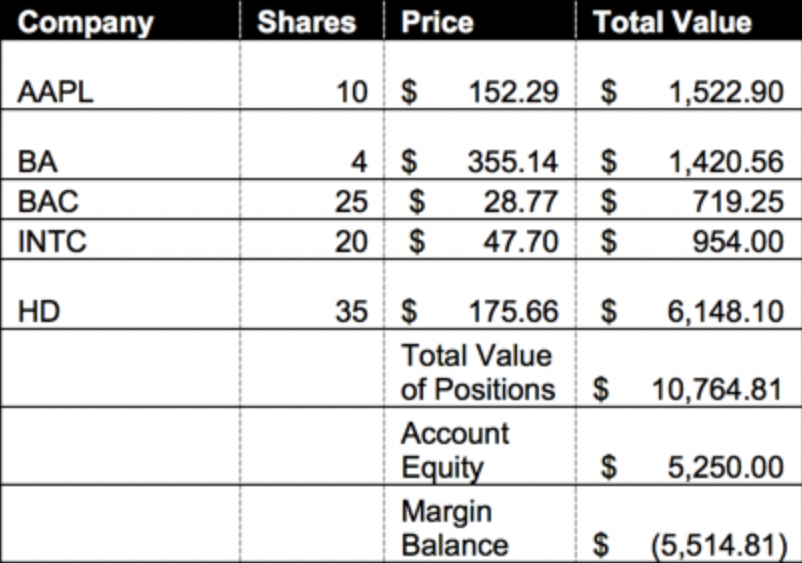During the market downturn, there are investors who have been overleveraging and ended up getting a margin call.
Because of which, there are people who says that using margin in investing is an absolute no-no. Why? Simply because margin is risky.
But here's the thing.
As Warren Buffett would say:
Risk comes from not knowing what you are doing
Personally, I have nothing against using margin.
But I absolutely object to those who use margin without knowing what they are getting into in the first place. This is why I never taught anyone using margin when they are just starting out.
What Exactly Is Margin
Buying on margin is borrowing money from a broker to purchase stock. You can think of it as a loan from your brokerage. And since you are borrowing money from the broker, naturally, you will have to pay interest on the loan.
Now, in what way can buying stocks on margin be a bad thing?
Well, the answer is a margin call.
A margin call occurs when the value of a margin account falls below the account’s maintenance margin requirement. It is a demand by a brokerage firm to bring the margin account’s balance up to the minimum maintenance margin requirement. To satisfy a margin call, the investor of the margin account must either deposit additional funds, deposit unmargined securities, or sell current positions.
Most brokerage have a built-in system to calculate what the maintenance margin requirement is. For TD Ameritrade, it is called maintenance requirement. If the total value of the portfolio falls below the maintenance requirement, then this will lead to a margin call.
This means that if you have a portfolio of poor quality stocks, and you happened to be using margin, if the portfolio of poor quality stocks falls below the maintenance margin, the broker will issue a margin call.
This is why I will always avoid poor quality companies - basically any company which fail my 8-Point Checklist.

Get Your 8-Point Checklist!
So that you know what stocks
to avoid investing in.
How I Use Margin Effectively
Now, this is only my personal view and what I personally use. So do exercise your own due diligence to determine what you are comfortable with. In short, don't just follow me just because I am personally doing it. If you know that you are not experienced yet, then simply don't use margin.
The beauty about margin is this - it increases your portfolio volatility. To beat the S&P 500 returns, very naturally, the volatility on your portfolio have to be higher than the S&P 500 index.
But how do I exactly manage this risk? Well, it boils down to this three factors:
- Use it only when the stock market is fearful
- Conviction of the stock going up in the long run
- Holding power to allow you to hold the shares for the long run
Once I have these three factors aligned, I know that I can use margin comfortably.
Margin is not something that I always use. In fact, I rarely have to use it as most of the time the stock market is a bull run. I only use margin when there is fear in the market, where there is a sharp correction or it is a bear market. As Warren Buffet would say, be greedy when others are fearful and be fearful when others are greedy. It would be silly of me not to take advantage of such opportunities.
Now, the second one is pretty straightforward for me. As long as I am investing in a qualified stock, I am pretty confident that the share price will increase in the long run. Sure, in the short run, there could be stock price fluctuations, but in the long run, I know it will likely go up.
Here's the thing - I need to be able to hold my margin positions for the long run. This is the simple rule of investing, where time is your best friend. So for those who are panicking and worried just because of one month of stock market downturn, do take a step back and adopt a long term view on your investments.
The third is important - which is something that most people do not touch on, that is holding power.
The use of margin is only effective if you do not get a margin call
This is why holding power is important.
Remember about maintenance margin requirement? It describes the amount of equity your portfolio needs to have before a margin call is triggered.
Personally, as I am more aggressive, I ensure that this maintenance margin is no more than 50% of my total stock equity.
This means that if my portfolio equity is $200,000 - I make sure that the maintenance margin is less than $100,000. A maintenance margin of $100,000 means that my portfolio will essentially have to fall by 50% of its value in order to get a margin call - which is quite hard considering that I only invest in qualified stocks.
The next is if you use margin such that you have a negative cash & sweep vehicle - you will have to pay interest on the margin balance.
Here's an example.

Here you can see that there is a margin balance of negative $5,514.81 - which is essentially what the person have borrowed from the broker. Let me remind this, the margin interest rate is around 10% - yes, a whopping 10%.
By a rule of thumb, I will always keep my margin balance positive so that I don't borrow money from the broker. If I do end up with a negative margin balance, I will make sure that it is only 10% of portfolio of my portfolio equity.
This is because so that the total interest rate on a portfolio basis, is only 1% a year - which can easily be covered by selling options.
If you need to know what your margin balance is currently - simply look at your "cash & sweep" vehicle in Thinkorswim. As long as it is positive, this tells you that you are not borrowing money from the broker.
To know your margin requirement and margin balance, I recorded a short video on how you can find these out using your ThinkorSwim Platform.
The Bottom Line
Margin can be a double edge sword, but it can essentially become a one-ended spear if we have a good knowledge of stocks fundamentals.
Whatever strategy you are using, please always only involve qualified stocks - because these are the stocks that with high confidence will continue to do well in the long run.
If you have still yet to watch my webinar on qualified stocks, do check my recorded training to find out more on what is it about.

The "Qualified Stocks" Training
What an engineer did to grow his portfolio from $7,137.68 to $194,383.30 in just 4 years using qualified stocks...so that WORKING AT A JOB was A CHOICE AND NOT A necessity...
